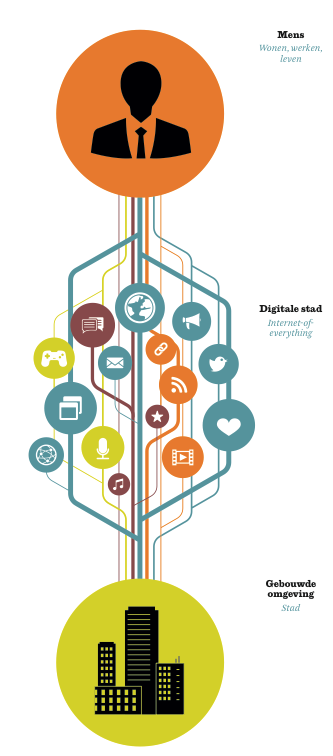In one of my former blogs I talked about my Smart City Radar. Apart from eight segments in which smart innovations take place, it also shows the three connecting layers of a city. These are the physical, planned city (both buildings, public space and infrastructure), the people inhabiting the city and, for the first time in history, the digital city. This layer is playing an increasing role and I consider it to be essential in the further development of smarter cities.
 I see great opportunities for companies and entrepreneurs to focus on this layer. Even more; I think it is mandatory to do so. It will be freeing a lot of jammed urban systems. In this digital world as connecting key between people and jammed city it will all happen next coming years!
I see great opportunities for companies and entrepreneurs to focus on this layer. Even more; I think it is mandatory to do so. It will be freeing a lot of jammed urban systems. In this digital world as connecting key between people and jammed city it will all happen next coming years!
It’s more than opening up a few more web shops though. A good example is the Dutch Hema (warehouse), which recently offers the possibility to 3D print your own designed necklaces and bracelets. People – as designer – connected to the physical world (Hema) through the digital layer.
3D printing is evolving fast and will totally change economics. Circular thinking (cradle-to cradle) is now becoming reality: it’s not just printing new products, but also shredding existing material into new building materials. This offers opportunities for new products, and for new entrepreneurship: a new chain of buyers and suppliers will arise. Software, the digital side, will play an essential role, especially in this transitory phase of the next 10 or 20 years.
3D printing is but one example, though an appealing one. Biggest opportunities are in connecting the physical city to people. I have just started my fourth year of teaching at the Hogeschool of Rotterdam in urban technologies: not at the faculty of civil engineering but at Communication, Media and Information Technology. Because in my opinion, there lies the key.
My classes are practical in the sense that I ask students to improve urban life or find a solution to an urban problem, thinking from new technologies. It truly shows the connecting role that the digital city is playing: the innovations of the students either rely on data of the physical city or on people as users (and their data).
What I mean: an example taking from parking problems. Do you use, as is now happening in London, sensor technology in parking spots (physical city) or do you develop an app that users will apply to transmit free parking spots when they notice one (people oriented)? Students usually see both sides as a way to the solution, but eventually choose only one for their concept or product. While for me the key to smarter entrepreneurship is in integrating both sides. Physical and people oriented developments and innovations will increasingly feed the digital layer with data.
My argument is clear robust: make use of all the opportunities that now arise, by employing connections in the digital city. Let technicians and social data designers meet. And be inspired by the many websites on smart(er) cities and creative entrepreneurs that already successfully use this digital layer.
(This blog was printed in Dutch in FD Magazine ‘Outlook’, April 2014 – read here the original Dutch version)

Leave a reply